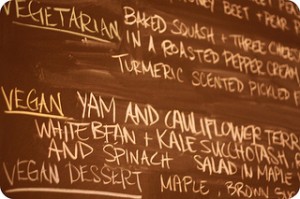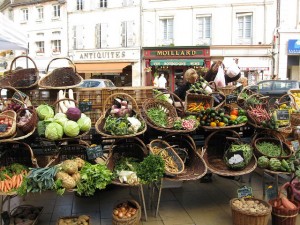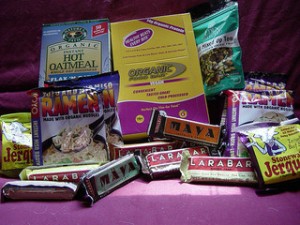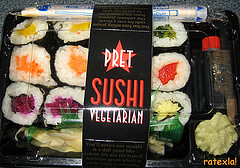Think it’s impossible to travel and stick to your vegan diet? Think again! With the right planning and troubleshooting, vegan travel can be easy as (vegan) pie.
 Vegetarianism – and veganism, especially – are not as prevalent in continental Europe as in the U.S. and UK, so finding vegan meals can be more challenging than in other destinations – particularly if you want to eat local specialties. However, there are still lots of options for vegans and with a little planning and adaptability, you can easily dine your way through the continent.
Vegetarianism – and veganism, especially – are not as prevalent in continental Europe as in the U.S. and UK, so finding vegan meals can be more challenging than in other destinations – particularly if you want to eat local specialties. However, there are still lots of options for vegans and with a little planning and adaptability, you can easily dine your way through the continent.
Meal Planning:
One of the smartest things you can do is research restaurants ahead of time. HappyCow is one of the most comprehensive resources available for vegan dining around the world. Research the specific cities and neighborhoods you’ll be visiting and plan your meals accordingly. Guidebooks can also be helpful for locating restaurants that cater to vegans or that have veg-friendly options. Forums and resources such as Lonely Planet provide first-hand experiences from people who’ve been to your destination. Just be aware that if you’re relying on a forum or guidebook, you should confirm each restaurant is still open before you arrive. Occasionally a restaurant featured in a guide may close after the book is published, so plan ahead to avoid disappointment (and starvation!) after a stressful day of business meetings or a long day of sightseeing.
 Pro Tip: Dining with business associates in a restaurant not of your choosing? Keep in mind easy tricks to veganize a meal at any restaurant, such as ordering pizza without cheese or pasta primavera cooked without butter or cheese. To make the best impression on your international colleagues, it’s a good idea to brush up on local etiquette as well.
Pro Tip: Dining with business associates in a restaurant not of your choosing? Keep in mind easy tricks to veganize a meal at any restaurant, such as ordering pizza without cheese or pasta primavera cooked without butter or cheese. To make the best impression on your international colleagues, it’s a good idea to brush up on local etiquette as well.
Will you have time to cook a few meals during your stay? If you’re up for preparing some of your own meals, you can shop in your destination for healthy and nutritious food that is free of animal products.
 Bonus: You’ll get to soak up local culture when you grab your ingredients at grocery stores and outdoor markets. Just be sure your accommodations have a kitchenette – even a minifridge and microwave allow you to prepare simple meals that meet your needs.
Bonus: You’ll get to soak up local culture when you grab your ingredients at grocery stores and outdoor markets. Just be sure your accommodations have a kitchenette – even a minifridge and microwave allow you to prepare simple meals that meet your needs.
Portable Snacks:
Even if you order a vegan meal for the plane (most airlines recommend special ordering your meal at least 24 hours in advance), sometimes the airlines mess up or they don’t have the meal you requested available. It’s wise to pack hearty snacks to help tide you over. Things like peanut butter (not found in Europe!) with crackers or bread, trail mix and whole fruits and vegetables are easy to pack and will keep you full during your journey. If you pack fruits and vegetables, be sure only to take enough for your flight, as you won’t be allowed to take produce from the U.S. past customs upon your arrival.
 Consider taking additional snacks or shopping at your destination for times when veggie meal options aren’t accessible. While it may be easy to find plenty of vegan carbohydrates as well as fruits and vegetables, if you’re not in an area where nuts and beans are common fare, you may need an extra protein boost. Packing a protein powder that can be mixed with water can be useful, as well as taking small packs of nuts that can be easily tucked in a handbag or backpack.
Consider taking additional snacks or shopping at your destination for times when veggie meal options aren’t accessible. While it may be easy to find plenty of vegan carbohydrates as well as fruits and vegetables, if you’re not in an area where nuts and beans are common fare, you may need an extra protein boost. Packing a protein powder that can be mixed with water can be useful, as well as taking small packs of nuts that can be easily tucked in a handbag or backpack.
Use Your Words:
 As you’re probably already aware, even seemingly vegan foods can have animal products lurking in them if you’re not eating in an establishment that specifically caters to vegans. For example, in some parts of Italy, egg may be an ingredient in the pasta. Or, in some Asian restaurants, a veggie entrée may still contain fish sauce. Soup may be made with chicken or beef broth. The only way to be certain if a meal fits your requirements is to ask what is in it. Be very specific. Some cultures may consider vegetarians as those who don’t eat beef but may assume you eat chicken or fish. Or, a vegetable dish may be cooked in animal fat…you get the idea. Your best bet is to brush up on common terms in your destination’s language so you can inquire and be specific about what you can and can’t eat. Learning some key food phrases can go a long way in helping you while traveling in Italy and France, for example. It’s also a great idea to brush up on some key phrases to show respect and politeness to those who are serving you.
As you’re probably already aware, even seemingly vegan foods can have animal products lurking in them if you’re not eating in an establishment that specifically caters to vegans. For example, in some parts of Italy, egg may be an ingredient in the pasta. Or, in some Asian restaurants, a veggie entrée may still contain fish sauce. Soup may be made with chicken or beef broth. The only way to be certain if a meal fits your requirements is to ask what is in it. Be very specific. Some cultures may consider vegetarians as those who don’t eat beef but may assume you eat chicken or fish. Or, a vegetable dish may be cooked in animal fat…you get the idea. Your best bet is to brush up on common terms in your destination’s language so you can inquire and be specific about what you can and can’t eat. Learning some key food phrases can go a long way in helping you while traveling in Italy and France, for example. It’s also a great idea to brush up on some key phrases to show respect and politeness to those who are serving you.
R-E-S-P-E-C-T:
When dining in a restaurant, or even more importantly in someone’s home, be respectful of local culture and views. Sure, you may have chosen your plant-happy diet for ethical reasons, but in some countries it may be considered extremely rude to refuse a local dish offered to you. Or, in some cultures, only the poorest individuals don’t eat meat and if you refuse, it could be considered insulting. Rather than launching into an explanation of why you are vegan (especially if there is a language barrier), be respectful and nonchalant about it. Although it may not be truthful, it may be easier to say that you are allergic or cannot digest the items you do not eat. Locals may be more accepting of this, making your overall dining experience more pleasant. At times you may feel singled out or get the impression that the restaurant staff finds your request extremely unusual. Don’t get ruffled about it. Remain polite to ensure you get good service, and if tipping is practiced in your destination, provide a very good tip to show your appreciation of the restaurant staff going out of their way to provide you with something delicious to eat. Check out this article for more information about how to order a vegan meal in any restaurant.
Bon apétit!
What are your tricks for eating vegan internationally? We’d love to hear from you in the comments below!
Safe Travels!
Photo Credits
Vegan Pizza from Arvind Grover
Farmers Market from Denise
Veg Menu from Jennifer
Vegan Snacks from Heather Kennedy
Vegan Sushi from Josphene Stenudd




